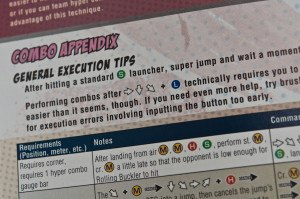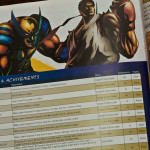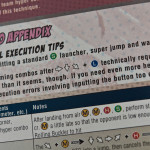 Marvel vs. Capcom 3 (or MvC3 for short) is quite possibly one of the most anticipated fighting sequels to grace consoles in recent years, and it does not disappoint. With an abundance of characters, a new art style, and some HD love, this is certainly going to be creating frat house arguments for years to come. Those who want an edge up on the competition should look no further than the wonderful BradyGames guide, as this book is packed with helpful tidbits of combat love that is sure to aid your blistered thumbs.
Marvel vs. Capcom 3 (or MvC3 for short) is quite possibly one of the most anticipated fighting sequels to grace consoles in recent years, and it does not disappoint. With an abundance of characters, a new art style, and some HD love, this is certainly going to be creating frat house arguments for years to come. Those who want an edge up on the competition should look no further than the wonderful BradyGames guide, as this book is packed with helpful tidbits of combat love that is sure to aid your blistered thumbs.
The guide starts out with some excellent breakdowns and directions on how it all comes together. For example, it points out that all the moves listed are based off your character standing on the left side of the screen. The guide then goes into great detail breaking down the basics of combat terms like footsies, frame rate, hyper armor, and so much more. Seriously, there are five and a half pages of terms to brush up on. You may never use them, but it is worth reading and makes it much easier to understand the rest of the content.
Once your morning terminology reading is done, the guide goes into a good amount of depth on the basics of the various game modes and combat fundamentals. This is a section that should certainly not be overlooked by novices to this series, and veterans will find it valuable for learning the new combat systems in place. Remember, MvC3 may look like a fast and furious button masher, but there is a deep fighting system buried under all that chaos. If you have no idea how to combo break, crossover assist, or trigger a team hyper combo, this section is a must read.
Finally we get to the meat and tatters portion of the guide: the character strategies. This is where BradyGames did a nice job when it comes to a fighting game strategy book. There is a fun profile giving a small chunk of bio information on each character, a power grid breaking down character stats, and even a display showing players what button to push to get various alternate costumes. It is basic, but nonetheless a nice touch.
The fighting moves start with basic attacks broken down by standing, crouching, aerial command, and crossover. Each section gives you a basic attack button to push, the hit count, damage, recovery time, and even a picture at the bottom to show you what the attack looks like. From here, special moves and hyper combos are detailed with descriptions on how they behave, like illustrating how the Plasma Beam from Dr. Doom will finish 15 frames faster if you use a Light Plasma Beam vs a Heavy Plasma Beam.
Finishing off the character section has some basic strategies and combos for players to add to their fighting repertoire. I did find this section to be useful for basics, but I would still turn to YouTube to watch the combos in action and pick up new tactics not detailed in this book.
The last section of the guide is reserved for Trophies, Achievements, icons, and titles. Trophies and Achievements are easily detailed on what you need to do, and I was able to acquire some basic trophies in a matter of moments thanks to the guide. The icons and titles are just as conveniently laid out, making it simple for fighters to quickly look up any title they want and see the conditions they need to meet in order to obtain said title.
Overall this is a great guide and I found little to no issues with the commands or tactics detailed for the various characters I tried. The part that will be inaccurate is not due to BradyGames, but rather Capcom and the player base. As specific characters are nerfed, and various combo strings adjusted, the damage numbers in the guide quickly become inaccurate. It is not a breaking point by any means, but remember that your favorite character may behave slightly different from what is in the guide. Outside that, this has become my bible for all things MvC3.
SGR Rating: 4/5
Authors: Joe Epstein, Adam Deets, Ian Rogers
Publisher: BradyGames
Editions Available: Paperback
Acquired via Publisher
- Easy to grasp combos make you king of online tournaments.
- MvC3 Strategy Guide Cover








